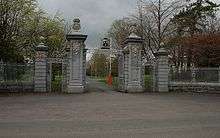St. Finian's College
| St. Finians's College | |
|---|---|
 Entrance gate | |
| Location | |
|
Mullingar, County Westmeath Ireland | |
| Coordinates | 53°32′20.466″N 7°21′18.999″W / 53.53901833°N 7.35527750°WCoordinates: 53°32′20.466″N 7°21′18.999″W / 53.53901833°N 7.35527750°W |
| Information | |
| School type | Secondary school |
| Religious affiliation(s) | Christian |
| Denomination | Catholicism |
| Patron saint(s) | Bishop of Meath |
| Founded | 1802 |
| Opened | May 2, 1802 |
| Founder | Rev. Patrick Plunkett, Bishop of Meath |
| President | Fr. Paul Connell |
| Principal | Fr. Paul Connell |
| Vice Principal | John McHale, Aisling Ryan |
| Chaplain | Father Mark English |
| Gender | Co-educational |
| Age range | 11- |
| Average class size | 25 |
| Student to teacher ratio | 1:1 |
| Colour(s) | Yellow and Brown/Black |
| Slogan | Deus Spes Mea |
| Nickname | Finians |
| Accreditation | Scientiae Fidimus |
| Affiliation | Diocese of Meath |
| Website | http://www.stfinianscollege.ie/ |
St. Finians College is a secondary school, the diocesan school of the Diocese of Meath.[1] It is located in Mullingar, County Westmeath, Ireland. Rev. Fr. Paul O'Connell, Ph.D. is its president. The school has two Vice Principals John McHale and Aisling Ryan.
Schola Cantorum
There are 29 Schola students.[2] Gerard Lillis is the current director, taking the position in 2003.[2] The Schola have in the past few years had many successful performances at Áras an Úachtaran, Feis Ceoil (Dublin), Glenstal Abbey and the National Principals Conference held in Killarney. At the moment, instruments taught at the school include organ, piano, violin, trumpet, clarinet, flute, as well as singing. Students currently come all over the country Dublin, Kildare, Laois, Longford, Sligo, Meath and Roscommon as part of the Schola Cantorum.
History
St. Finian's College was founded in Navan, County Meath as the Meath Diocesan College, by the Bishop of Meath, Patrick Plunkett, and opened on May 2, 1802.[3] Fr. Eugene O’Reilly as its first president, serving until 1827. The college moved to Mullingar, County Westmeath, at the beginning of the twentieth century. The present college building built by J.J. O'Callaghan was opened in February 1905. In 1970, St. Finian's was selected by the Irish Catholic hierarchy as the location for the music school (Schola Cantorum).
2002 marked the bicentenary of the founding of St. Finian's College. In 2003 it opened to girls, and in 2007 the last boarding class graduated.[4] The school also began offering transition year to students in 2017, thanks to the work of Sinéad Garvin and David Andrews. This transition year program introduced laptops into the school, beginning an era of technology for the school.
In 2015, the St. Finian's Diocesan crest was removed and replaced with a secular logo with the inclusion of a textbook. This move was seen by many to be an attempt to curry favour with the Department of Education as a means to receive greater state funding.
Sports
The school offers a variety of sport choices, with its many sports facilities, such as Gaelic Football, Soccer, Hurling, Handball, Basketball, Rugby and Golf.
The Mullingar Cricket Club plays in the grounds of St. Finian's College.[5]
Presidents of St. Finian's College
- Fr. Eugene O'Reilly (1802-1827)
- Fr. Patrick O’Connor (1827-)
- Fr. Nicholas Power (-1867)
- Dr Thomas Nulty, D.D., (Acting)
- Rev. Joseph Higgins (-1884)
- Rev. Bernard Duff (1884-1886)
- Fr. John Cassidy (1886-1891)
- Fr. Michael Dooley (1891-1903)
- Fr. Denis Flynn (1903-)
- Fr. Jack Kearney (? - 1967)
- Fr. Piers Sheridan (1967 - 1970?)
- Fr. Jim Deignan (1970-1980)
- Fr. Sean Fay (1980-1984)
- Fr. Mathew Mollen (1984-?)
- Fr. Rodney Stuart (?-?)
- Fr. Paul Connell, B.A., Ph.D. (?-present)
References
- ↑ "Archived copy". Archived from the original on 2011-07-21. Retrieved 2010-07-28.
- 1 2 http://www.scholacantorum.ie/pupils&staff.html Archived 2011-07-21 at the Wayback Machine.
- ↑ St. Finian's College Navan History Website.
- ↑ Seat of Learning www.irishidentity.com
- ↑ Location Mullingar Cricket Club - Official Website.